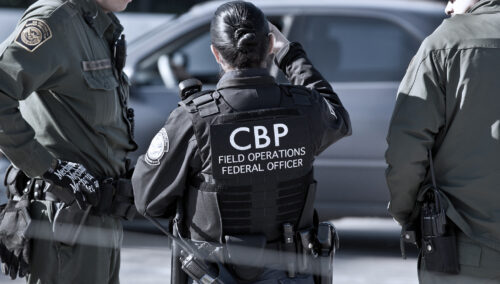Since 1986, controlling illegal immigration by regulating who is entitled to work in the United States has been a key component of U.S. immigration policy. The ritual of showing proof of one’s identity and work authorization and filling out an I-9 form is part of every new hire’s paperwork haze.
First piloted in 1997 and known as the Basic Pilot, an electronic employment-verification program has been used as a complement to the paperwork process—an effort to use technology to improve compliance. Now known as E-Verify, the program is a federal, web-based program through which U.S. businesses can attempt to verify the work authorization of new hires. E-Verify is primarily a voluntary system. However, the federal government requires that all of its contractors use it, and some states have made it mandatory as well.
E-Verify is a compliance mechanism. But, somewhere along the way, it became confused with a deportation strategy. Calls for mandatory E-Verify tend to portray the program as a solution to our illegal immigration problem, and a way to generate jobs for unemployed Americans.
The reality is quite different. Mandatory E-Verify without comprehensive immigration reform will not end illegal immigration, free up jobs for unemployed Americans, or save the country money. In fact, studies of E-Verify predict the opposite.
E-Verify alone will not force unauthorized workers to leave the country.
- E-Verify cannot detect all unauthorized workers. According to the Government Accountability Office (GAO), if unauthorized workers present genuine identity and employment-eligibility documents that are borrowed or stolen, E-Verify will erroneously confirm them as work authorized. Westat estimated that 6.2% of employees put through the system were not authorized to work in the U.S., but 54% of those were incorrectly confirmed by E-Verify.
- Employers can hire unauthorized workers in the underground economy. Mandatory E-Verify will not work as planned in the context of a dysfunctional immigration system in which unauthorized workers make up approximately 5% of the workforce, and employers lack legal channels to hire the immigrant workers they need. Unscrupulous employers will continue to game the system and hire these workers off-the-books in the unregulated, untaxed economy. This hurts law-abiding employers and U.S. workers who cannot compete against vulnerable, easily exploitable workers. The focus of enforcement must be bad employers who exploit their workers.
- Arizona, which has mandatory E-Verify, has already experienced this shift to the underground economy. According to economist Elliott Pollack, “It’s an effect of the sanctions (law) that is exacerbated by the bad economy. What you’ve done, because of that law, is taken tax-paying people” and shifted them off the tax rolls.
Expansion of E-Verify will not create jobs for U.S. citizens—and may put some U.S. citizens out of a job.
- Errors and employer misuse of E-Verify mean that tens of thousands of U.S. citizens and legal workers could be denied their jobs and their paychecks. While E-Verify’s accuracy rates have increased, the Department of Homeland Security (DHS) and Social Security Administration (SSA) databases upon which E-Verify relies still contain errors. Any American worker could be denied work because of an error. For example, workers who naturalize, marry, divorce, or have multiple or hyphenated surnames may receive erroneous results from E-Verify.
- Some workers will have to navigate government bureaucracies to keep their jobs. Workers who are informed of an error in their records will spend hours to days away from work, navigating the bureaucratic maze of the SSA and DHS, trying to correct the mistake. GAO found that workers are limited in their ability to correct errors in DHS records. In some cases, workers must file a Privacy Act or Freedom of Information Act (FOIA) request to gain access to their personal records—a daunting process that could take more than 104 days.
- Employers sometimes don’t inform workers that there’s a problem. Sometimes employers do not notify workers that they received a TNC, which means the workers don’t have a chance to correct their records and may lose their jobs. A survey of immigrant workers in Arizona found that 33.5% of them had been fired without being notified of a TNC, and didn’t have a chance to contest the result.
- In its independent evaluation of E-Verify, Westat found that approximately 0.8% of all E-Verify queries resulted in an erroneous “tentative nonconfirmation” (TNC) notice, which means the databases cannot immediately confirm that the worker is employment-authorized. For every one million workers queried, that’s 8,000 work-authorized people who are told they’re not authorized to work. There are approximately 154 million workers in the U.S., and employers hire roughly 60 million workers annually.
- In Fiscal Year (FY) 2009 more than 211,000 newly hired workers received a TNC. Of these, 0.3% (or 24,600) resolved the errors and inaccuracies and were later determined to be work authorized. About 189,000 received final nonconfirmations, but that doesn’t mean they were all unauthorized workers. Some were unauthorized, others were legal workers who did not contest the TNC.
E-Verify is expensive for businesses, stretching their resources and limiting their ability hire more workers.
- According to Bloomberg News Service, making E-Verify mandatory would cost $2.7 billion a year. The biggest burden would be on small businesses (those with less than 500 workers), which account for 99.7% of employers. Small businesses would have to pay $2.6 billion a year.
- In FY 2008, employers collectively spent $43 million to use E-Verify. Small businesses spent $36 million. It cost a business an average of $63 to run a worker through E-Verify. It cost small businesses (the majority of all employers) $127 to run one worker through the system.
- System errors are costly for employers. When workers receive erroneous nonconfirmations and have to fix their records, it affects the workers’ and employers’ productivity.
- Slightly more than 246,000 employers are currently registered for E-Verify—only 3% of all employers in the country. Making E-Verify mandatory would mean millions of employers would have to sign up and use the system.
Further expansion of E-Verify will cost the government and U.S. taxpayers billions of dollars.
- U.S. Citizenship and Immigration Services (USCIS) estimates that funding E-Verify as a non-mandatory system will cost $508 million over the next 10 years. GAO called that estimate “minimally credible.” A mandatory system would cost much more.
- Mandatory E-Verify would mean less tax revenue for the federal government. The Congressional Budget Office estimated that a mandatory E-Verify program would decrease federal revenues by $17.3 billion over 10 years due to the number of workers leaving the formal economy and working in the unregulated, untaxed underground economy.
Bad for the Bottom Line
Misplaced efforts to expand E-verify as an immigration-enforcement tool are ultimately bad for the bottom line. There is no guarantee that any undocumented workers will leave the country as a result of E-Verify, nor will it prevent identity theft. Businesses, the government, and workers will pay a price in lost time, revenue, and income because the system is simply not designed to solve all the problems its proponents suggest. Addressing the real problems of a workforce that relies on undocumented immigrants requires a more comprehensive package of reforms, including a legalization program that brings workers into compliance and out of the shadows, making it easier for employers to use programs like E-verify with greater confidence that they are doing the right thing.



